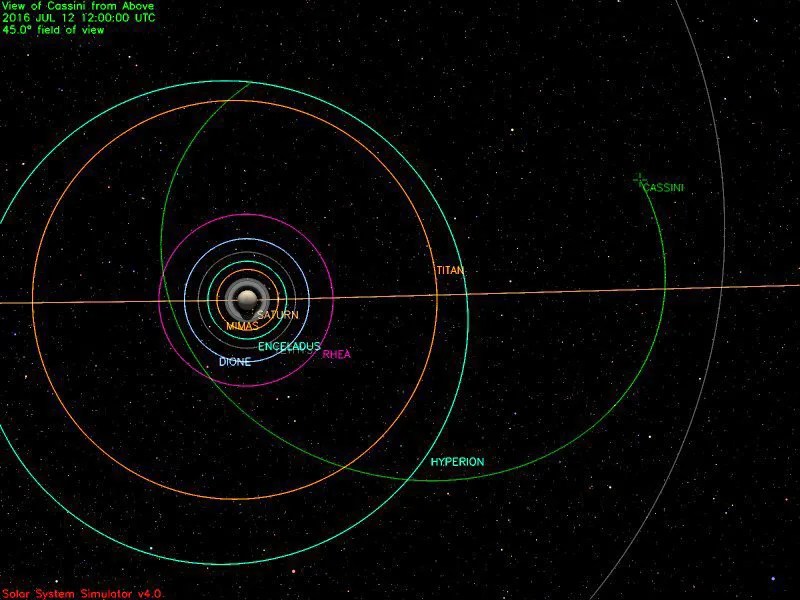3 min read
Cassini is orbiting Saturn with a period of 23.9 days in a plane inclined 43 degrees from the planet's equatorial plane. The most recent spacecraft tracking and telemetry data were obtained on June 29, using the 70-meter diameter Deep Space Network station in Spain. The spacecraft continues to be in an excellent state of health with all of its subsystems operating normally except for the instrument issues described at http://saturn.jpl.nasa.gov/anomalies .
Cassini usually executes a targeted encounter with Saturn's moon Titan, or a smaller moon, on each of the spacecraft's trips around the planet. During the past orbit no such encounter was included, so Cassini's orbit period and inclination remain unchanged. A new orbit, #238, began this week which will include the Titan T-121 close encounter on July 25, for the purpose of science observations and orbit shaping.
Wednesday, July 6 (DOY 188)
Cassini's Ultraviolet Imaging Spectrograph (UVIS) continued controlling the spacecraft's attitude as it made mosaic scans of Saturn, its magnetosphere, and its rings. This 217-hour series of observations began on July 3, and continued through Saturday interrupted only by engineering activities and communications sessions with the Deep Space Network (DSN).
Thursday, July 7 (DOY 189)
Saturn continues to offer dazzling views for anyone with a small telescope. Its wide rings and golden color provide a nice contrast in the sky to nearby Mars and Antares. Saturn is but one of the objects pointed out in this month's "What's Up" video: /news/489/whats-up-2016-archive/ .
Saturday, July 9 (DOY 191)
When UVIS wrapped up its current set of observations, the Imaging Science Subsystem (ISS) led a 90-minute observation in the Titan monitoring campaign while the hazy, planet-like moon was at a distance of 2.4 million kilometers from the spacecraft. The Visible and Infrared Mapping Spectrometer (VIMS) participated. When this was finished, ISS led VIMS in a one-hour satellite orbit campaign observation, looking at small objects near the planet. This pair of observations repeated on Monday. When today's was finished, UVIS took up another mosaic scan of the Saturn system, this one lasting 34 hours, with ISS and VIMS riding along.
Monday, July 10 (DOY 192)
Cassini's final 10-week command sequence, S101, will begin controlling the spacecraft's activities in one year from today.
Monday, July 11 (DOY 193)
Cassini coasted through apoapsis in its orbit of Saturn, having climbed out to 2.5 million km while slowing to 8,676 km per hour relative to the planet. This marked the start of Cassini's orbit #238 of the ringed planet. The viewing geometry from Cassini at that point is illustrated here.
Still taking advantage of this high altitude, high-inclination view, UVIS began another 34-hour mosaic scan of the Saturn system.
Eighteen months ago Cassini was in a much lower-inclination orbit. A view of the planet from back then captures Saturn's moon Tethys off in the distance: /resources/17384 .
Tuesday, July 12 (DOY 194)
On four occasions during the week, while Cassini's optical instruments were pointing at or near Saturn, ISS carried out two-minute Saturn storm-watch observations. VIMS rode along with two of them.
The Deep Space Network communicated with and tracked Cassini seven times this week, using stations in California and Australia. A total of 10 individual commands were uplinked, and about 942 megabytes of telemetry data were downlinked and captured at rates as high as 124,426 bits per second.
Milestones spanning the whole orbital tour are listed here: /news/10059/saturn-tour-dates-2016/ .
An illustration of Cassini's path up to mid-day July 12, 2016.








